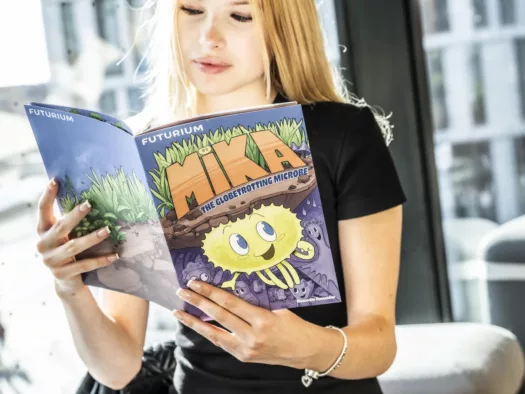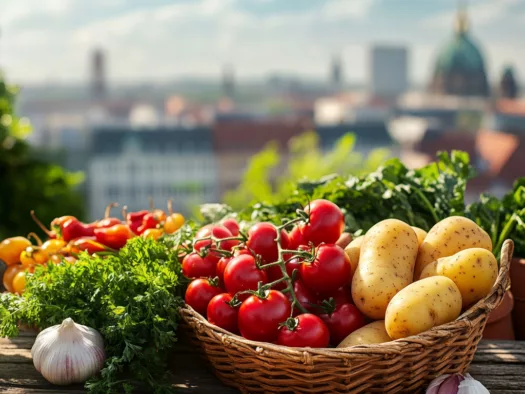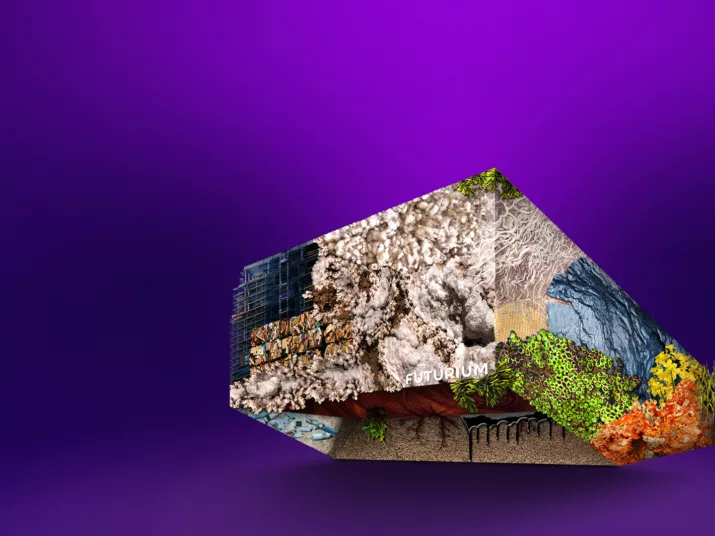
Farming and using the land
Fields of the Future
Our morning coffee and bread rolls, the cotton for our clothes, the wood in our furniture – without agriculture, our everyday lives are inconceivable. It feeds us and provides us with important raw materials. It shapes landscapes and societies alike. Yet we often take it for granted. At the same time, agriculture is criticised for contributing to climate change, for damaging ecosystems and for threatening biodiversity. All the while, agriculture itself is strongly affected by these developments. A vicious circle.
We’re facing major challenges: how can we provide healthy nutrition for all humans on earth without harming nature? How can we secure the livelihoods of farmers? Policy-makers can promote fair land use and support small farms. Farmers can protect their soil and make their fields more resistant to extreme weather conditions. Researchers have long been investigating new cultivation methods and developing smart technologies. And what can consumers do? We can choose our products more sustainably, for instance. Futurium’s new focus deals with the question of how we’ll be farming and using the land in the future. In the exhibition, in the Lab and at events, you can discover a wide range of approaches – from the use of AI and indoor farming to methods such as agroforestry. Let’s find out together how we can farm our fields of the future successfully!
Superland – A future-field installation
A garden in the middle of grey concrete: wooden beams growing together criss-cross to make trellises that are overgrown with greenery to form a cooling canopy of leaves. The plants, sprouting and blooming, will be arranged on five levels. Our installation “Superland” by Parzelle X and artist Benjamin Frick will bring the thematic focus “Fields of the Future” to Futurium in a very idiosyncratic way. Whether food security, climate change or biodiversity loss – agriculture is facing major challenges. The installation will present building blocks for solutions, including new and very old seeds, a moor and a forest garden. And it aims to appeal to all the senses – with the green of the plants, the buzzing of the insects, and the smell of the soil and the flowers. Even life underground will be made experienceable by acoustically amplifying the invisible processes in the soil and making them tangible as vibrations. “Superland” is envisioned as a living system between art and science that grows and constantly changes – despite all the adversities of everyday life.
In the exhibition
More than 10,000 years ago, humankind took up agriculture and animal husbandry. Since then, human life – like the face of the earth itself – has been changing at increasingly dramatic speed... In the exhibition, you can find out the challenges facing us today and in the future in all areas related to “modern agriculture” – and what sort of solutions are already being worked on.
A game to introduce you to community-supported agriculture
Many people want to eat regional produce and know more about where their food comes from. At the same time, the number of small farms going to the wall is on the rise. To save more farms, holistic solutions are needed from policymakers and business players. One approach that has been tried and tested on a small scale is community-supported agriculture (CSA), whereby consumers become “members” of a farm. Our game to introduce you to this concept will take you through a harvest year and demonstrate how CSA works, what decisions have to be made and what challenges need to be overcome. Play in teams of three and decide together!
Indoor farming – the city as farm
Researchers are testing how to grow important basic foods indoors all over the world. For example, by using extremely fast-growing club wheat that was actually developed for space travel. The vision is to create a high-rise building in which the plants grow on top of each other in a hundred layers. Vegetables and herbs can also grow in old factory buildings or empty offices – temporarily, at least, because space in major cities is becoming increasingly scarce in many places. “Indoor farms” are also struggling with high energy prices. Where could they be built permanently in the future? And how could cities, in the long term, cover part of their needs themselves?
Agrivoltaics
Should we use a plot of land to grow food or to generate energy? There’s little room for both. What would be even better would be to use space for both purposes at the same time. This works if solar cells aren’t placed directly on fields, but high above them. Or if they’re installed on lakes. Solar power systems are more efficient if they’re cooled by water, while the panels protect the lakes from evaporation. Generating energy, promoting biodiversity and strengthening agriculture: the Spitalhöfe Solar Park in Villingen-Schwenningen shows how it’s done.
Half Earth
Today, many areas have already been designated as nature conservation areas. However, on our touchable globe, “The Half Earth”, you can see that areas providing a habitat to a particularly large number of rare species are not yet protected. How can different forms of land use be reconciled with much-needed nature conservation? You’ll find a few proposed solutions in the exhibition. Beforehand, you can listen to this interview with scientist Antje Boetius and find out why biodiversity is so important, how nature can be preserved and how each and every one of us can do our bit.
Visit the new “Future Fields” exhibits in our permanent exhibition.
New audio guide tour
Would you like to find all the agricultural exhibits in the exhibition? Then simply go on our new themed tour “Future Fields”. It’ll take you directly to the right places and provide you with all sorts of useful information. And the good thing is: you don’t have to download anything! Simply connect to the Wi-Fi, use your own headphones, access the page and off you go! Click here to get to our audio guide. Click here for our audio guide.
In the Lab
Future Landscape Simulator
Land becomes a space for decision-making: What should take priority – food production or biodiversity? Urban development or renaturalisation? Should we focus on the needs of today or those of tomorrow?
Using building blocks, you design landscapes: fields, forests, wetlands, settlements, solar farms. The physical structures you build are brought to life through a digital projection. In real time, the effects of land-use decisions become visible: CO₂ is absorbed or released, species disappear or return, harvests rise or fall. Find out more here.
Double Harvest
Changing perspectives: You explore a range of virtual landscapes, showing what sustainable farming might look like in practice. The first station takes you on a virtual tractor ride through a landscape. Across three varied scenarios, you can discover how power generation via photovoltaics and agriculture can be combined on the same land. At the second station, you explore the concept of agroforestry – the combination of trees and shrubs with crop cultivation. An interactive tour illustrates how this nature-focused farming method promotes greater biodiversity. The third station puts you in the perspective of a bumblebee. Towering blades of grass, oversized plants, and magnified animals create an immersive micro-world, bringing the diversity and importance of ecological systems vividly to life. Find our more here.
Shared Grounds
With “Shared Grounds”, the Futurium invites you to explore the complex topic of soil in a participatory way – through dialogue with the exhibit and in accompanying workshops. The evolving installation, which continuously changes with your contributions, serves as a playground for thoughts, ideas, and models. With each vision and prototype added by you, it grows into a collective representation of possible futures. Find our more here.
Invisible – Visible
What lies hidden when we look at a plant? How does it grow beneath the soil’s surface? Digital technologies can help us better understand the interactions between plants, soil, and the environment. Cameras, sensors, and algorithms capture information that often remains invisible to the human eye. This way, we learn to understand the language of plants and use resources more consciously. Two murals show how these technologies can be applied. Find our more here.
The Comic
Mika – The Globetrotting Microbe
May we introduce you to Mika? She’s a curious little soil microbe. When she learns at school about human beings, she finds herself bursting with desire to use her own sensors to explore the world above ground. No sooner said than done! Yet the journey is far more dangerous than she ever thought it would be. But Mika encounters wondrous creatures with special abilities and in this way learns a lot about life above and below ground. Will she also find her way to human beings? This comic – developed by Futurium together with illustrator Alexander Roncaldier – has been available free-of-charge since 14 September 2025, exclusively at Futurium.

Photo: Jan Windszus
Discover Berlin! Out and about with Futurium
“Futurium has left the building” is the motto for this summer: as part of our event series in June and July 2025, you can find Futurium at four special locations in Berlin. Here you can look into the various facets of our new thematic focus “Future Fields. Farming and Using the Land” from an urban perspective. The events will be organised with committed locals and present concrete approaches to shaping the future of our city. Each event will be dedicated to a new topic. Exchange everyday expertise, gain insights into research findings, try out new techniques and engage in unusual conversations!
This event series took place in June and July 2025.


